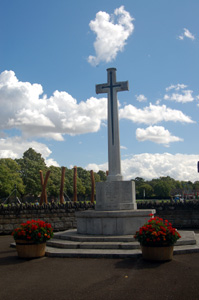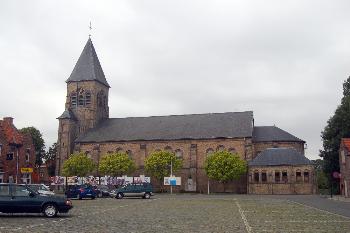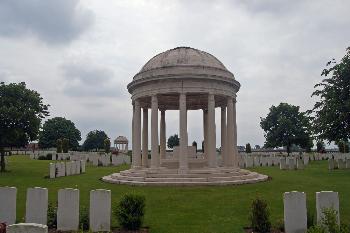Deaths of Sandy Men in 1914

Sandy war memorial August 2010
The Sandy war memorial stands next to the recreation ground on Bedford Road. It contains 126 names of Sandy men killed in the First World War. The size of Sandy, including its hamlets was 3,377 in the 1911 census. Of these men 53 were killed serving with the Bedfordshire Regiment. Bedfordshire and Luton Archives and Records Service has the war diaries of each of the battalions of the regiment to see active service. The numbers of Sandy dead for the Regiment each year are as follows:
- 1914: 4
- 1915: 6
- 1916: 10
- 1917: 22
- 1918: 10
- 1919: 1
The numbers killed with each battalion were as follows:
- 1st Battalion: 19
- 2nd Battalion: 11
- 4th Battalion: 4
- 1st/5th Battalion: 2
- 6th Battalion: 3
- 7th Battalion: 11
- 8th Battalion: 3
All four Sandy men killed in 1914 served with the 1st Battalion and were killed in action in the bloody fighting around the Belgian city of Ypres. This city lies a few miles from the French border and was the last little bit of Belgium not occupied by the Germans. It was the symbolic significance of this fact, as much as its strategic value (a place to stop the German advance on the Channel ports, so vital to Britain's wat effort), which meant that the Allies defended it so heroically throughout the war - a siege, in effect, of four years duration. In fact the city nearly fell in the fighting which came to be called the First Battle of Ypres. A German attack on 30th October almost broke through the British Army's lines. There were no reserves left to counter-attack such a breakthrough and the city would have fallen had the Germans made one more determined effort, but they had lost many men in their continued assaults ,which had begun on 19th October and were exhausted, and so the city was saved. Despite the crisis having passed fighting continued until 22nd November.
The first men from Sandy to die with the Bedfords were Walter Emery and Charles William Braybrooks, who were both killed in action on 7th October. Like the other two Sandy men to die in 1914 Walter and Charles were regular soldiers who had joined the colours before the start of the war. Their numbers were 8766 and 8764 respectively, suggesting they had joined up together, the numbers themselves indicating that this was between September and December 1906. Number 8765, Edward Quince, was killed in 1916 and presumably joined up with them.
Both Emery and Braybrooks had been born in Sandy. Their entries on the Commonwealth War Graves Commission website notes that Braybrooks was the son of Charles and Mary Braybrooks of Longfield Road. Neither man's body was recovered and they are commemorated on the Le Touret memorial to the Missing. The battalion war diary [X550/2/5] states that the unit was in front line trenches south of the Menin Road and east of Hooge, which they had occupied the previous day. The British army had been pushed out of the town of Geluveld, half a mile or so east, some days before, though the Bedfords had not taken part in that fighting.

Geluveld Church June 2009
On the 7th the Bavarian Cavalry Division, fighting on foot, broke through a line held by the neighbouring unit, 1st Battalion, Lincolnshire Regiment, about 200 yards to the left of the Bedfords. This unit fell back in disorder, taking the regiment on their left, 1st Battalion Northumberland Fusiliers, and some of the Bedfords with them. The Bedfords reserves came up and the battalion counterattacked, driving the enemy back. The diary notes that Quartermaster Sergeant Byford, later awarded the Distinguished Conduct Medal for his actions, got together a part of forty men and captured a trench held by the Germans. A Private Falla (also later awarded the DCM) ran on in advance of this party and shot down the line of the trench, taking their attention away from the rest of Byford's band who then stormed the trench in a frontal assault. During the day the battalion lost seven officers and one hundred and forty other ranks, killed and wounded, and seven missing.
By coincidence the other two men from Sandy were both killed just two days later on 9th November. Nothing serious had taken place on 8th but on 9th the diary records that two non-commissioned officers, Sergeant Mart and Corporal Cyster succeeded in creeping up to a German trench where two of the battalion's machine guns had been previously lost, presumably on 7th. They found only one German actually with guns, although the adjoining trench, a few yards away, was occupied. Mart shot the German and the guns were safely brought back. A wounded soldier, presumably British, though the diary does not say so, was also found in the trench and he was brought back by Mart assisted by 2nd Lieutenant Garrod and others. Mart & Garrod in turns facing the enemy to keep their heads down by accurate fire at a few yards range. The battalion were thanked in a wire from the Corps Commander, Sir Herbert Smith-Dorrien, one of the few survivors of the massacre at Isandlwana in the Zulu War of 1879, for this gallant little action. The diary records that seventeen men were killed and seven wounded though it is not clear if these were all from Mart's party or whether they were losses occurring through the day from sniping and shell fire. The latter seems more likely.

Bedford House Cemetery June 2009
The two Sandy men were Lieutenant Walter Francis Graves and Private David Wheatley. Lieutenant Graves is buried, appropriately enough, in the nearby Bedford House Cemetery, one of the larger cemeteries around Ypres, with just over five thousand burials. He was the son of Walter Graves of Sandye Place and was twenty nine years old. Private David Wheatley came from Beeston Green, his wife living in Park Road, Sandy, by the time the Commonwealth War Graves Commission gathered its information. His body was never recovered and he, like Walter Emery and Charles Braybrooks, is commemorated on the Le Touret Memorial.